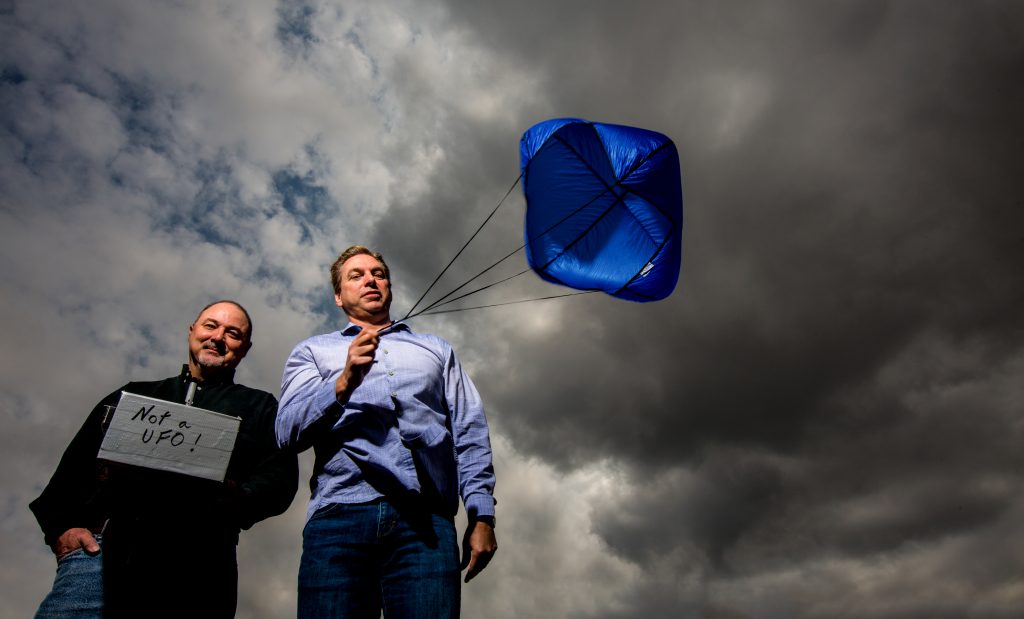
Pegasus II mission sends balloon high above Earth and invites you along for an Internet of Things ride
Matt Long and Mark Nichols have a particular affinity for balloons – but not the kind that you see at birthday parties or ride with in big baskets, or find in 80s one-hit wonders. They’re focused on the kind that can go to near space – and take thousands of people along for the ride, virtually, in a demonstration of the Internet of Things in action.
“When you bring people into technology, people become participants in technology,” Long says. “Thousands will be watching in real time. Within 20 milliseconds you’re seeing it on your phone. People will also be able to send messages to the craft during the flight with their phones. That message will be displayed and video recorded into the flight record with background of near space.”
They’ve built a compact probe from scratch that a high-altitude balloon will float 100,000 feet above the earth, where it’s minus 75 degrees Fahrenheit. Their team will be able to remotely control it, gather a ton of data, release it after two hours and document its journey through videos and photos. And most importantly to this team, back here on Earth, anyone will be able to follow along through their website and mobile app.
“We’re doing something that hasn’t been done before, giving people a live experience of a place they can’t travel to get that view. It’s a great adventure and sense of experimentation,” Long says. “No one’s done live camera and telemetry.”
The mission is called Pegasus, and they’ve already launched this project once, back in January 2015. Now they’re ready to take it up into the atmosphere Wednesday, if the weather cooperates, but this time, they’ve learned a lot since their first go-around and they’ve implemented changes to make the Pegasus II mission even better for those who want to tag along.
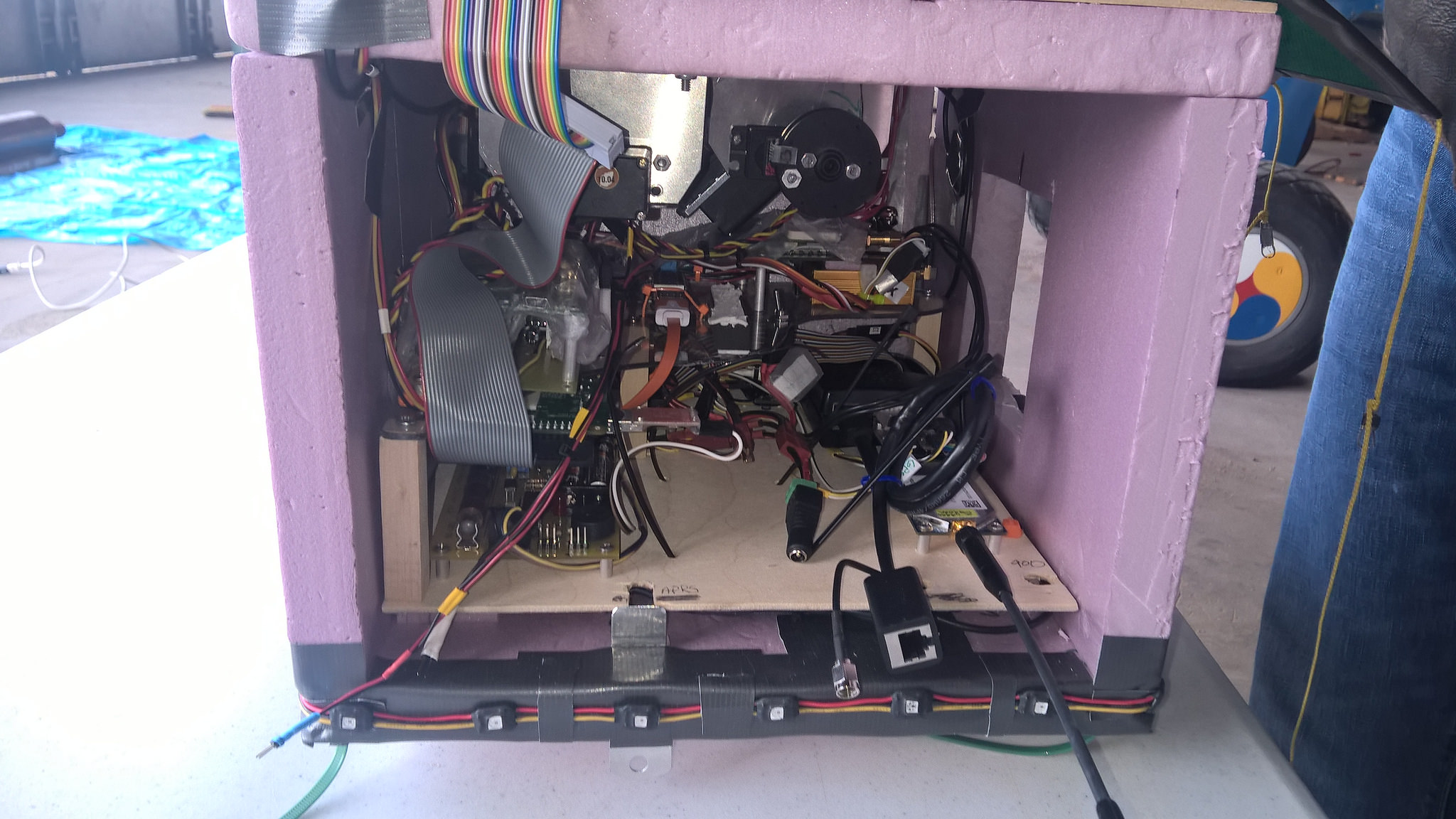
“In the first one, we had a single processor on board, and there were maybe 10 sensors on board. This one will have five processors on board, and it will send telemetry down with about 39 sensor measurements,” says Nichols. “We have multiple GPS units and every major system on board is backed up in duplicate. If something on board fails, it’ll switch to the backup.”
Pegasus II’s new features include: radiation measurements with a Geiger counter and a sensor for UV rays, craft health sensors and five video cameras, including one that’ll send a live feed down from the craft to the website during the flight.
The payload, which was only about four pounds on the first flight, is now more like eight. The balloon is also much bigger, at 8 feet 6 inches in diameter and containing 270 cubic feet of helium, almost double the first balloon.
But when they first came up with this idea, they thought about something they could fly over attendees at the 2015 TechReady conference at Microsoft headquarters. Long entertained all kinds of ideas, including robots, drones and even an inflatable shark with a tail that flies through the air.
“In my bizarre head, I wondered, what else could you fly? The robotic experience is cool, but it’s not something you can participate in as a crowd. I looked at if anyone had done this with a high-altitude balloon. With a balloon, you can change the whole paradigm, get it out to large audience. On Nov. 7, 2014, I sent an email to Mark with ‘Must Do This’ in the subject line. His response: ‘Absolutely.’”
Long and Nichols worked as architects on the same at Microsoft – the Azure Center of Excellence, where they helped customers architect solutions for the Microsoft Cloud. Educated as an engineer and as a scientist, respectively, in Memphis and Chicago, they swapped roles for the Pegasus mission.
Nichols, a craftsman who enjoys rebuilding cars and building houses in addition to his day job, got to build the probe – a simple, insulated box with a lot of sophisticated equipment inside.
“I’m a civil engineer who always wanted to be a scientist; Mark is a scientist who always to be an engineer. We got to do what we didn’t graduate in,” Long says.
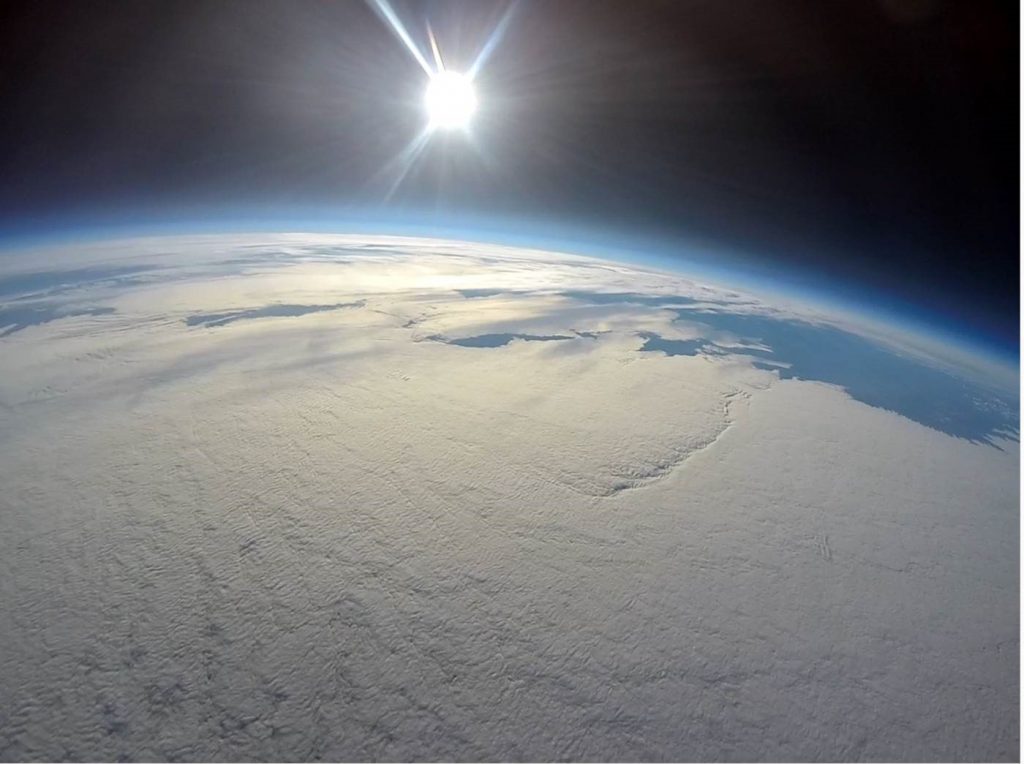
For that first launch last year, Nichols was the engineer in charge of the payload (the probe and its delivery system, the high altitude balloon) and mechanics. Long took care of aeronautical engineering and operational technology – Piraeus software – that runs in the cloud to relay information from the upper atmosphere to those following the project in only a few milliseconds. That technology also gave them the ability to show how the Internet of Things can work in a hostile environment, allowing them to remotely control the payload through actions such as releasing the balloon and deploying a parachute. The experiment also included mapping the balloon to a Bing Map in real time, which showed its location during the flight.
“It was such a leap of experiences we haven’t had before, and we turned it into an experiment,” Nichols says. “We wanted to push the envelope as far as we possibly could. But we put all our cards on the table on this one flight. The only way to test was to put it in the air. The best part of it all is that it worked.”
With the operational technology, they were able to take a payload, communicate with people to be a part of the experience and control flight operations. It’s similar to how thousands of consumers can buy phone apps that give them the same service, such as locking their doors.
“The whole purpose is to use operational technology to do amazing things very simply – like a Jacques Cousteau trip, but in a balloon. Everyone always remembers his videos and pictures,” Long says. “You can connect things with people and participate in unusual ways. Without the experience, the technology isn’t interesting. If you can couple that technology to something that’s really interesting, that’s our goal, to do something nobody else would do and bring the user into an experience through the technology.”
Piraeus uses Project Orleans, a platform developed by Microsoft Research that provides a straightforward approach to building high-scale distributed computing applications. It simplifies programming for developers by removing the need to learn and apply complex concurrency logic or scaling patterns. Designed for cloud use, Orleans has been used extensively in Microsoft Azure and is open source.
“Orleans was the missing ingredient that gave us great scale and speed,” Long says. “Funny story, I built this whole system and it didn’t work for us. Six weeks later, Sergey Bykov gave a presentation on Orleans, and I realized this was the missing technology I’d been looking for, for eight years. Everything he tells me is everything I need to make this happen. This is technology nobody else in the world has. It enables me to very simply create things on the fly and connect two parties that don’t know anything about each other very, very quickly – like an imaginary pipe of communication between two parties. It took us a quest of many years to find something to do exactly what Orleans does.”
Thanks to Orleans’ ease of programming, there’s no need to learn complicated systems, says Bykov, the Microsoft researcher whose presentation captivated Long. “And we wanted to make it easy to run distributed systems, then make apps scalable by default – the app can scale through hundreds of servers right away. You can associate any objects with each other, (and they can) can talk to each other. It magically works with a cluster of machines. And, it can process millions of messages per second. It can handle a high load of messages and support millions of devices, like in gaming.”
Long says it was a very attractive solution that processed telemetry in real time.
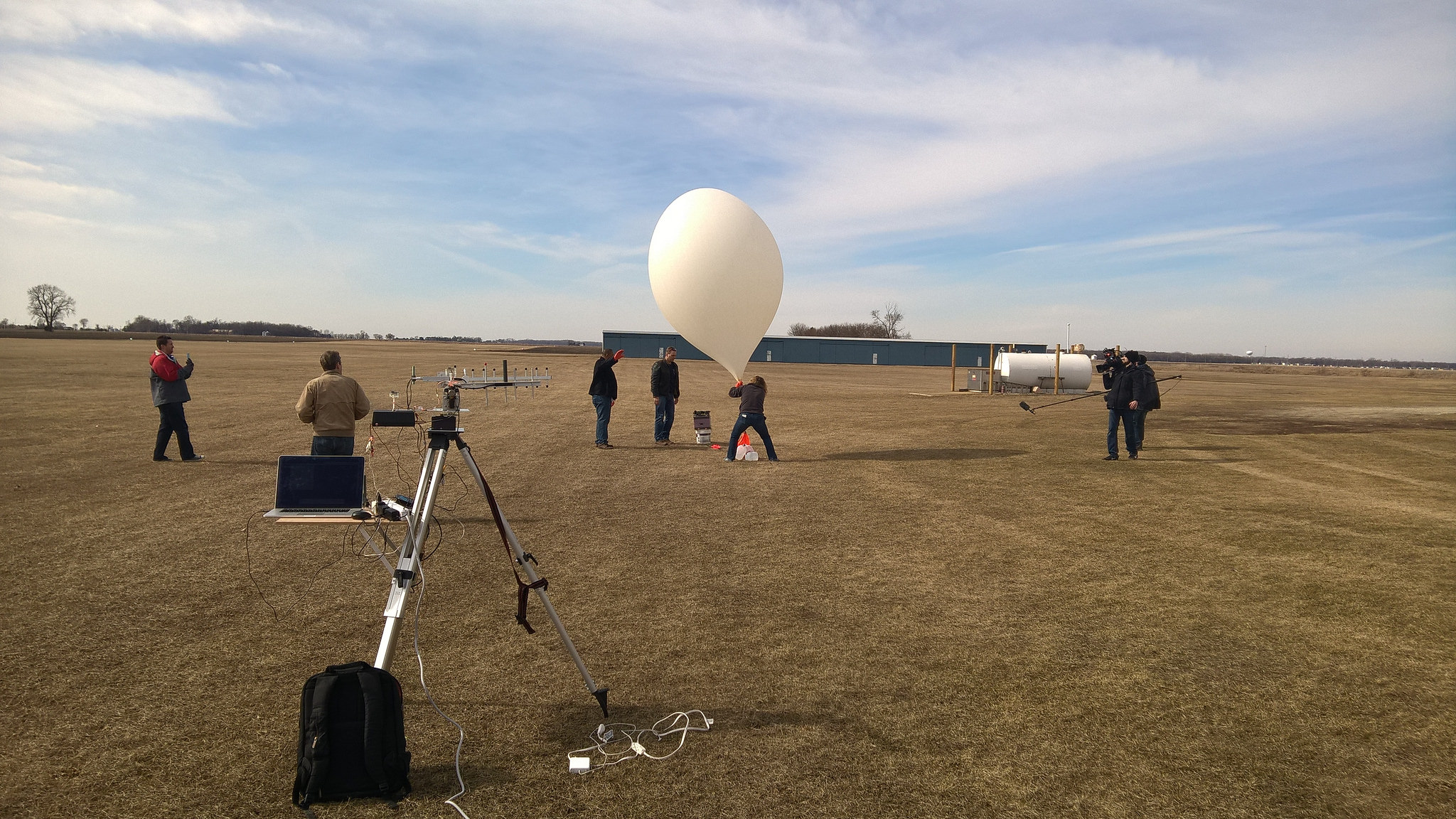
Prior to finding Orleans, Nichols’ research landed on ham radio, which gave them the ability to send out location information – but they were limited by characters (what Nichols calls “old-school Twitter”) and could only convey information once per minute.
“I liked it because it was out there, available and proven,” Nichols says. “The problem is, we couldn’t send commands and couldn’t tell it to do anything. We couldn’t send much information back.”
Pegasus was connected to ground stations over two-way radios, and the ground stations connected to phones through Piraeus. Piraeus connected to the website to see information coming up to the balloon, and storage accounts kept it all in Azure so they could live together as one unit, one solution. Once it left the ground station, information went into the cloud.
But even with all the elements in place, the January 2015 launch had its share of obstacles, like the recovery of the first probe, which they’d almost given up on finding after they lost GPS contact with it on its 212 mph descent.
“We released the balloon and its descent was more than 200 mph. That violent spin affected one of the antenna connections of GPS and we lost GPS data, as it fell. But other telemetry kept coming, like pressure sensor data and altitude from the pressure sensor, as it came down to earth. And then, 30 seconds prior to it impacting to the earth, the GPS came back online. It’s a miracle it came back on, sending data. That’s part of what made this flight so incredible.”
But they weren’t meant to find it that day.
“Now packed up and getting dark, we began the 3+ hour drive back to Seattle, disappointed without the recovery of the Pegasus I,” Long documented on the Pegasus Mission blog.
Almost a week after it landed, they found it, not far from where they launched it in Othello, Washington. They’d decided to stay an extra day in the area and make the 250-mile drive to the site after they received information about its possible location.
“At first we didn’t think we were going to be able to find it again,” Nichols says. “We initially thought it could be anywhere within a radius of a couple miles, a needle in a haystack.”
As Long wrote on the blog, “Mark pulled out of the business toward the same point that he had started and noticed some orange out the left side of the automobile. He stopped. He saw some green, it looked like trash in a field. If the drogue parachute was orange and white, what could be green but the shroud lines of the main parachute? Mark approached and there it was. Pegasus I fully intact and only 800 feet from where we thought it to be. Piraeus was not only critical to real-time flight operations and distributing to others to view, it also saved Pegasus I’s dying breaths of GPS location.”
It was a happy ending to a story that began with an idea to experiment with a high-altitude balloon going 16 miles above the surface of the earth.
From that first launch to this one, their team has expanded, matching the increased payload and balloon size.
“We’ve got more than 45 people inside Microsoft – across the company and the world, from South America, to India, to Singapore – who are helping us with this,” Long says. “We’re just thrilled about it. This team has grown and grown, as have the logistics, for this risky launch. We have to be ready to go, and we’re learning lessons. There’s a lot of choreography.”
They’re also now using Azure Data Factory to handle the information going to the cloud.
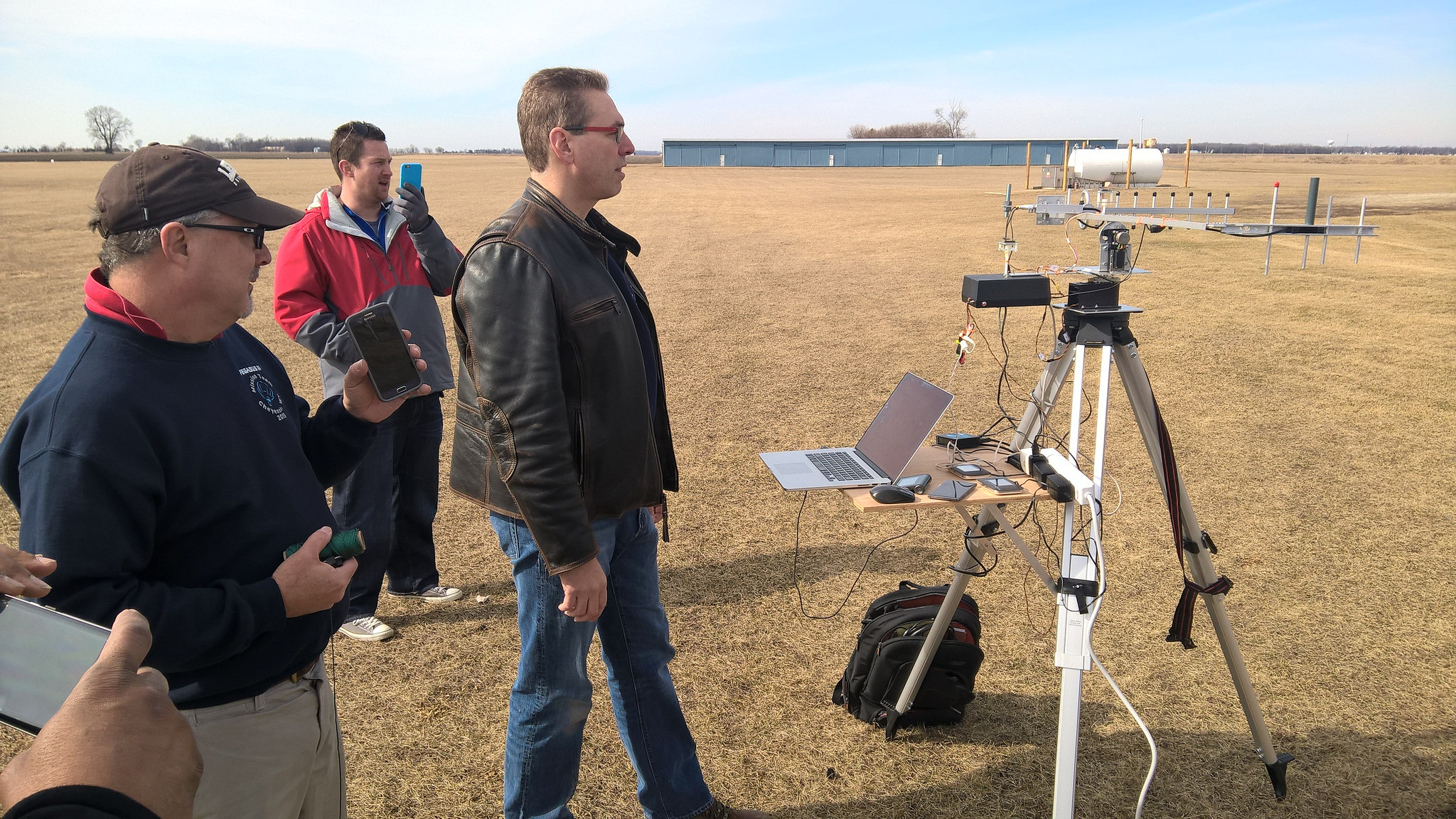
The team expects at least 10,000 people to follow along via the website and mobile app, including those who witnessed the first launch.
“I was spell-bound by the video footage captured of the curvature of the Earth, especially after reading about the trials and tribulations of the mission itself,” says Molina Warty, who at the time was the San Francisco-based director of Strategic Initiatives for Cerego, a technology startup focused on life-long learning grounded in cognitive neuroscience.
Warty, who had previously worked with Long on an Azure project, stumbled across his blog on the first Pegasus mission and says she “was fascinated and intrigued to learn more” because she is “interested in the application of technology to stretch the limits of the human potential in broadening horizons.”
“The Pegasus mission, as Matt says, truly is at the intersection of STEM fields,” Warty adds. “But it goes a step further in transcending STEM by being a beacon for possibilities; the sheer manifestation of the human imagination, the courage to keep pushing boundaries, and the conviction to undertake worthy adventures at all costs. It is this complex simplicity that makes the Pegasus mission both unique and important.”
Follow along with the latest Pegasus mission – and be a part of it, sending texts to the craft during the flight. Enjoy the ride.
Matt Long (left) and Mark Nichols show off the Pegasus mission payload and parachute. (Photo credit: Scott Eklund/Red Box Pictures.)















